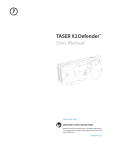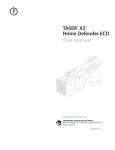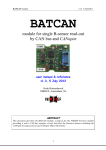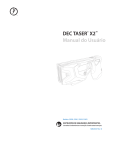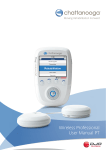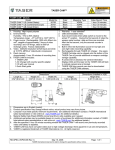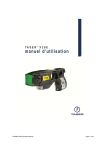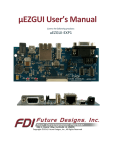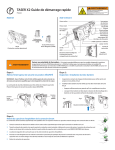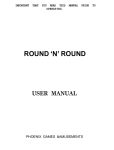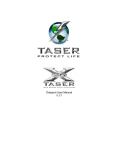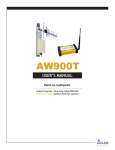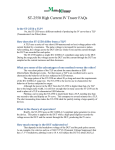Download TASER X26c ECD User Manual
Transcript
O p e ra t i n g M a n u a l Citizen TA S E R ® X 2 6 C IMPORTANT SAFETY AND HEALTH INFORMATION Read, understand and follow the warnings and safety instructions contained in the enclosed Product Warnings document included with this weapon. The most current warnings are posted on our web site at www.TASER.com. Do not attempt to use this device until you have read and understand this manual. This warning label appears on TASER device models. TASER® Electronic Control Devices (ECDs) for citizens are weapons designed for lawful selfdefense or defense of others by temporarily incapacitating a person from a reasonably safe distance while reducing the likelihood of serious injuries or death. Though they have been found to be a safer and more effective alternative when used as directed to other traditional self-defense use-of-force tools and techniques, it is important to remember that the very nature of self-defense, use of force, and physical confrontation or incapacitation involves a degree of risk that someone will get hurt or may even be killed due to physical exertion, unforeseen circumstances, and/or individual susceptibilities. TASER® X26C Operating Manual • MMU0007 Rev: A OPERATIONAL SAFETY To minimize the risk of injury before, during, and after use, consider the following: MINIMIZE RISKS BEFORE USE • • • • Read and Heed. Read, understand and follow all warnings and instructions before using the TASER X26C. Complete Training First. Do not attempt to use a TASER device unless you have read and understood this manual. Obey Applicable Laws. Carry and use the TASER device in accordance with applicable federal, state, and local laws. Store in a Secure Location. Store the TASER X26C in a secure location inaccessible to children and other unauthorized persons. TASER devices are not toys, and users should avoid any inappropriate brandishings, deployments and/or activations, which may result in serious bodily harm to the user or others, including animals. MINIMIZE RISKS DURING USE • • • • • • Avoid Torturous or Other Misuse. Assume Device is Loaded. Always assume that a TASER device is loaded. Do not point a TASER device at anything you do not intend to hit. Avoid Unintentional Activation. Keep finger away from trigger until ready to use. Keep Body Parts Away From Front. Keep your hands and body parts away from the front of the TASER Cartridge. Avoid Static Electricity Discharge. Avoid contact between static electricity and the TASER Cartridge because static electricity can cause unexpected discharge. Do not point the laser at the eyes or stare into the beam. TASER® X26C Operating Manual • MMU0007 Rev: A FLAMMABILITY Beware – TASER Devices Can Ignite Explosive Materials, Liquids or Vapors. These include gasoline, other flammables, explosive materials, liquids, or vapors (e.g., gases found in sewer lines, methamphetamine labs, and butane-type lighters). Some self-defense sprays (for example, pepper sprays) use flammable carriers such as alcohol and could be dangerous to use in immediate conjunction with TASER devices. Some self-defense sprays labeled “non-flammable” may ignite when used in conjunction with TASER devices. OWNERSHIP Do not give a TASER X26C away as a gift or sell it without filling in the registration card or transfer card. Do not give or sell a TASER device to anyone not authorized to own it. For more information, see the Legality section of this manual. Taking a TASER-brand device out of the country is prohibited by law. If traveling on an airplane (domestic U.S.), you must put the TASER X26C in your checked luggage; it cannot be carried onboard. Although the TASER X26C is not classified as a firearm, you should carry the TASER X26C in a hard case and advise the Transportation Security Administration (TSA) and airline personnel prior to bag screen that you are carrying the TASER device in your checked baggage. Do not point a TASER device at any law enforcement officer or do anything that would cause law enforcement officers to feel threatened by your use of the TASER device. Because the TASER device is able to incapacitate a person, law enforcement officers may be justified to use lethal force to protect themselves. Do not carry TASER Cartridges in your pockets as they can be fired by electrostatic discharge. It is recommended that you carry the TASER device only in a certified holster or carrying case. TASER® X26C Operating Manual • MMU0007 Rev: A WHAT IS THE TASER X26C? The TASER X26C is a software upgradable electronic control device manufactured by TASER International, Inc. Electronic Control Devices (ECDs) use propelled wires or direct contact to conduct energy to affect the sensory and motor functions of the nervous system. The TASER X26C uses a replaceable cartridge containing compressed nitrogen to deploy two small probes that are attached to the TASER X26C by insulated conductive wires with a maximum length of 15 feet. The TASER X26C transmits electrical pulses along the wires and into the body affecting the sensory and motor functions of the peripheral nervous system. The energy can penetrate up to two cumulative inches of clothing, or one inch per probe. NEUROMUSCULAR INCAPACITATION (NMI) The human nervous system communicates with simple electrical impulses. The command center (brain and spinal cord) processes information and makes decisions. The peripheral nervous system includes the sensory and motor nerves. The sensory nerves carry information from the body to the brain (temperature, touch, etc.). The motor nerves carry commands from the brain to the muscles to control movement and can be involuntary in response to the sensory information. An example would be the involuntary muscle reaction to pull a hand away from a hot object. TASER technology uses similar electrical impulses to cause stimulation that affects the sensory and motor nerves. Neuromuscular Incapacitation (NMI) occurs when a device is able to cause involuntary stimulation of both the sensory nerves and the motor nerves. It is not dependent on pain and is effective on subjects with a high level of pain tolerance. Previous generations of stun guns could primarily affect the sensory nerves only, resulting in pain compliance. A person with a very high tolerance to pain (e.g., a drug user or a trained, focused fighter) might be able to fight through the pain of a traditional stun gun. TASER® X26C Operating Manual • MMU0007 Rev: A COMMON EFFECTS OF NMI The use of TASER technology is designed to cause incapacitation and involuntary muscle contractions, making secondary injuries a possibility. These potential injuries include but are not limited to: cuts, bruises, impact injuries, and abrasions caused by falling, and strain-related injuries from muscle contractions such as muscle or tendon tears, or stress fractures. These injuries are secondary in nature and not directly attributable to the electric stimulation of the TASER device, but are possible consequences of the involuntary muscle contractions the TASER device induces to produce incapacitation. Some of the effects may include: • Subject may fall immediately to the ground and be unable to catch him/herself. • Subjects located in the water may drown if their ability to move is restricted. • Subject may yell or scream. • Involuntary muscle contractions of varying degrees. • Subject may freeze in place with legs locked. • Subject may feel dazed for several seconds/minutes. • Potential vertigo. • Temporary tingling sensation. • May experience critical stress amnesia (may not remember any pain). For a full list of warnings, see www.TASER.com. BASIC X26C ELECTRICAL THEORY • • • • • • Electricity must be able to flow between the probes or the electrodes. Electricity generally follows the path of least resistance between the probes. The greater the spread between the probes on the target, generally the greater the NMI effectiveness. Electricity will generally not pass to others in contact with the subject unless contact is made directly between or on the probes. Electricity can arc through clothing. Exposure to water will not cause electrocution or increase the power to the subject (the electrical charge is fixed inside the TASER device, and will not increase significantly even with environmental changes). Modern pacemakers and implanted cardiac defibrillators withstand external electrical defibrillators at least 800 times stronger than the TASER conducted energy pulses. TASER® X26C Operating Manual • MMU0007 Rev: A TASER X26C AND CARTRIDGE FEATURES The X26C is constructed of impact-resistant sonic welded polymer and weighs approximately 7 ounces. Various color options are available. See www.TASER.com for the most current specifications. HIGH VISIBILITY SIGHTS TASER CARTRIDGE AFIDs ILLUMINATION SELECTOR CARTRIDGE RELEASE TAB TASER WIRE SAFETY SWITCH STAINLESS STEEL SHOCK PLATES PROBES LASER SIGHT BLAST DOORS DPM RELEASE BUTTON TRIGGER (LIL) LOW INTENSITY LIGHTS (LEDs) (DPM) DIGITAL TEXTURED GRIP ZONES POWER MAGAZINE SAFETY SWITCH: Ambidextrous safety switch can be operated from either side. • • • • • Safety Switch down (SAFE). Safety Switch up (ARMED) and ready to deploy. Do not block the safety switch on one side of the X26C while attempting to move it on the other side. This can break the safety switch and disable the device. If the X26C safety switch is left in the up (ARMED) position for more than 20 minutes, the system will shut down to preserve digital power magazine (DPM) battery life. To re-arm the weapon, simply cycle the safety switch to the down (SAFE) position, then back to the up (ARMED) position. TASER® X26C Operating Manual • MMU0007 Rev: A DIGITAL POWER MAGAZINE (DPM) OR XDPM The Digital Power Magazine is much more than just a lithium energy cell power supply system for the X26C. In addition to the battery of two 3volt lithium energy cells that power the X26C, the DPM also contains an onboard memory chip that maintains a record of the remaining power. The X26C keeps track of how the various features of the weapon are affecting the energy cell life and updates the memory in the DPM accordingly. The battery percentage indicated is a calculated value and not a direct reading of the battery charge. Do not store the DPM anywhere that the gold contacts on the top of the DPM may touch metal objects. If the DPM is short-circuited, the DPM will malfunction and the energy lost during the short circuit will not be registered or tracked in the DPM. The DPM also contains memory that can update the X26C device software, and add extended warranties, to the X26C. Visit www.TASER.com for more detailed warranty information. The X26C must be stored with the DPM/XDPM inserted at all times. If the DPM/XDPM is left out of the device for an extended period of time, software in the X26C may be damaged resulting in possible failure of the device and the date/time may be reset. The DPM has enough power for approximately 150 ten-second firings depending on temperature and other factors. The DPM will use more energy in colder weather than in warm weather. For the most current specifications, see www.TASER.com. The XDPM has all the same features as the DPM plus a holder for a spare TASER Cartridge. CENTRAL INFORMATION DISPLAY (CID) The CID is a two-digit display on the back of the X26C that provides the following information: DPM POWER LEVEL (ENERGY CELL INDICATOR): When the safety switch is up (ARMED), the CID will display the percentage of DPM power remaining. This indication will last for 5 seconds. After 5 seconds, the CID will display two dots to indicate the weapon remains armed. TRIGGER SWITCH AND SPARK DURATION: Unlike a firearm trigger, the TASER X26C trigger is a momentary electrical switch. The switch is operational only when the safety switch is in the up (ARMED) position. When the X26C is deployed, it delivers a 10-second Shaped Pulse energy burst of short-duration electrical impulses. The CID TASER® X26C Operating Manual • MMU0007 Rev: A displays a countdown from 10 to 0 indicating how many seconds remain in the current burst. The burst can be stopped at any time by positioning the safety switch to the down (SAFE) position. Pulling the trigger two more times during the burst cycle will increase the total electrical discharge cycle time to 30 seconds. Continually holding the trigger will result in continuous discharge until the trigger switch is released or, the DPM is depleted. See the Using the TASER X26C section for more information. WARNING: In the event of an accidental discharge, immediately move the safety switch to the down (SAFE) position to stop the discharge cycle. X26C STATUS DATA: When a DPM is inserted in the X26C, the device will enter a “boot-up” sequence and cycle through the following information: EXAMPLE: 07..09..03--07..08..09..12..22--27--18 07 Warranty expiration year (2007) 09 Warranty expiration month (September) 03 Warranty expiration date (3rd) 07 Current year (2007) 08 Current month (August) 09 Current date (9th) 12 Current hour (GMT) 22 Current minutes 27 Internal temperature of the X26C (27 ºC) 18 X26C software version (18) ILLUMINATION SELECTOR (LASER AND LED FLASHLIGHTS) The operator can select four modes of illumination when using the X26C. To change the illumination setting: TASER® X26C Operating Manual • MMU0007 Rev: A 1. 2. 3. Place the safety switch in the down (SAFE) position, remove the TASER Cartridge, and aim the X26C in a safe direction (such as toward the ground). NOTE: The illumination selector is disabled if the safety switch is in the up (ARMED) position. Press and hold the Illumination Selector for approximately 1 second until the CID display illuminates. Press and release the Illumination Selector to toggle through the four available settings until the desired setting is designated on the CID. Stop when the desired setting is displayed. NOTE: Using pens or paper clips to press the Illumination Selector may damage it. LF: LO: OF: OO: Laser and Flashlight both illuminate Laser Only will illuminate Only Flashlight will illuminate Neither the Laser nor the Flashlight will illuminate and the CID display is dimmed The selected mode displays for 5 seconds, and will be the default mode the next time the safety switch is moved to the up (ARMED) position. HIGH VISIBILITY SIGHTS The mechanical sights on the X26C are molded in a contrasting color to provide manual aiming of the X26C. ELECTRODES The front of the X26C contains two metal electrodes. These electrodes direct the charge to the electrodes on the cartridge to initiate deployment of the probes. In addition, the electrodes provide the ability to use the X26C in a “drive-stun” mode as a traditional stun gun-type device. STAINLESS STEEL “SHOCK” PLATES The sides of the DPM compartment have stainless steel “shock” plates for added strength. Shock plates are available in silver and black colors. 10 TASER® X26C Operating Manual • MMU0007 Rev: A TEXTURED GRIP ZONES The handle of the X26C is optimized for maximum grip in minimal size. Textured grip zones strategically located in the areas of maximum hand-to-weapon friction offer superior grip and weapon control under stress. SOFT BODY HOLSTER The X26C ships with a soft body holster that conveniently stores the TASER X26C on the belt or in a purse. Do not apply pressure to the sides of the soft body holster while drawing the TASER X26C. This could release the cartridge from the TASER X26C. INCORRECT TASER® X26C Operating Manual • MMU0007 Rev: A 11 CORRECT TASER CARTRIDGES Specifications are available at www.TASER.com and are subject to change without notice. NITROGEN GAS CAPSULE & PRIMER WIRE SPOOL AFID STACK CASSETTE ELECTRODE PORON PADS EJECTORS CASSETTE WEDGE AFID LABEL SNAP ON BLAST DOOR MYLAR CARTRIDGE CUTAWAY TOP PROBE IS “HORIZONTAL” RELATIVE TO THE WEAPON 8º BOTTOM PROBE POINTS 8º DOWN 15’ CARTRIDGE 12 TASER® X26C Operating Manual • MMU0007 Rev: A BLUNT FRONT PROBE ASSEMBLY AVOIDING UNINTENTIONAL DISCHARGE Never attempt to open or modify a TASER Cartridge. Tampering with a live TASER Cartridge could cause it to discharge or malfunction (which may result in injury). Handle all TASER Cartridges with care. Probes may deploy unexpectedly if exposed to physical shock or static electricity. Additionally, the firing sequence for all TASER Cartridges is designed to be initiated by an electrostatic discharge delivered by the TASER device. This is an important design and functional element for the TASER device and cartridge. However, an electrostatic discharge can come from many sources. When an electrostatic discharge, regardless of the source, contacts the front of a TASER Cartridge, it is possible for the cartridge to discharge. Therefore, avoid contact between static electricity and the TASER Cartridge because static electricity can cause unexpected discharge. TASER Cartridges should be kept away from conditions known to create an electrostatic discharge, such as rubbing cloth (i.e. jacket liner) across a cartridge in an environment known to create static shocks. Although highly unlikely, it is possible for TASER Cartridges to deploy outside of the TASER device, or in a device that has not been activated due to contact with an electrostatic discharge. Care should be taken to keep electrostatic discharge away from TASER Cartridges. Occasionally, blast doors will be knocked off the front of a cartridge. Because those cartridges cannot be relied upon to discharge, TASER International recommends disposing of these cartridges. TASER operators should not attempt to fire a cartridge with no blast doors on it unless they are facing an immediate threat and do not have the time or option to reload. Attempting to deploy a cartridge with no blast doors could result in a charge being created and held in the wires. Any conductive material that comes into contact with the front of the cartridge, even after the cycle has ended, could draw the charge to the ignition pin and deploy the probes. ANTI-FELON IDENTIFICATION (AFID) TAGS Every time a TASER Cartridge is deployed, at least 24 small confettilike AFID tags are ejected. Each AFID is printed with the serial number of the cartridge deployed, allowing law enforcement agencies to determine the registered owner of the cartridge and track citizen use if ever used in a criminal act. TASER® X26C Operating Manual • MMU0007 Rev: A 13 OPERATING THE X26C SPARK TEST A spark test should be conducted once every six months (as you would check your smoke detector batteries). The reasons for the spark test include: • To verify the TASER device is working. • To verify that the DPM is adequately charged. • There are components in the high voltage section of the X26C that are more reliable when energized (“conditioned”) on a regular basis. Spark Test Instructions 1. Verify that the safety switch is in the down (SAFE) position. 2. Verify that the TASER Cartridge is removed. A spark test should never be conducted with a TASER Cartridge in the device. 3. Point the device in a safe direction (such as the floor) and verify that your fingers and no part of your body are in front of the device. 4. Place the safety switch in the up (ARMED) position. 5. Depress the trigger and confirm sparking across the electrodes at a rapid rate. 6. Place the safety switch in the down (SAFE) position. 14 TASER® X26C Operating Manual • MMU0007 Rev: A LOAD THE TASER CARTRIDGES WARNING: Never place your hands, fingers, or any part of your body in front of the cartridge. When loading and unloading, always hold the cartridge on the sides or top. LOADED UNLOADED LOADING: 1. Verify that the safety switch is in the down (SAFE) position. 2. Point the device in a safe direction 3. Place the cartridge into the front of the weapon until an audible click is heard. 4. Verify that the cartridge is secure by gently pulling on the sides of the cartridge. UNLOADING: 1. Verify that the safety switch is in the down (SAFE) position. 2. Point the device in a safe direction. 3. Depress the tabs on the sides of the cartridge and remove. The TASER Cartridges for the X26C are specifically designed so there is no “up” or “down” position –enabling you to quickly reload one in a stressful situation without worrying about putting it in upside down. TASER® X26C Operating Manual • MMU0007 Rev: A 15 AIMING AND PROBE PLACEMENT Normally, aim the laser of the device at one of the large muscle groups (center of mass) such as the torso or thigh areas. The top probe impacts the target near the laser beam; however, the probe impact distance from the laser beam will vary depending on the distance between the device and the target. See www.TASER.com for current specifications. The bottom probe impacts at an 8-degree angle from the top probe. This results in a spread of approximately 1’ for every 7’ of distance from the target. Greater probe spread increases effectiveness. If possible, a minimum 4-inch spread between the probes is recommended. 1’ 7’ Hold the X26C device so that the cartridge is vertical for an upright target. WARNING: Avoid head, face, throat, or groin exposure, unless operator safety dictates otherwise. 16 TASER® X26C Operating Manual • MMU0007 Rev: A USING THE TASER X26C The TASER X26C is a serious, state-of-the-art defensive weapon and should be treated accordingly. Although the unit is designed to be as nonviolent as possible in stopping a combatant, its use can result in injuries, including but not limited to a probe embedded in an eye or secondary injuries related to falling. For a full list of warnings, see www.TASER. com/safety. Be sure, however, not to fire at a subject who is over 15 feet or 4.5 meters away (measure 15 feet or 4.5 meters to see how far this is – it will probably be further than you think). If you do deploy at someone more than 15 feet or 4.5 meters away, the probes will not have sufficient TASER wire to reach the target. The TASER device is to be used only for lawful self-defense or in the defense of others. Check your state and local laws for applicable regulations. Depending on local and state laws, the TASER X26C may be kept in the house for home protection, or carried in a car, purse, etc., for personal protection when away from home. Be sure to research each state’s applicable laws prior to possessing or transporting the device across state lines, or into other states where laws may vary. A TASER device is not a substitute for other preventive self-protection actions such as ensuring doors are locked, and parking in well-lighted areas. Deployment Instructions 1. 2. 3. 4. 5. 6. 7. 8. 9. Remove the TASER X26C from the holster and verify that the TASER Cartridge is installed. If a subject approaches in a suspicious or threatening manner, place the safety switch in the up (ARMED) position. Aim the laser beam at the center of the attacker’s torso or the attacker’s legs. Scream and shout verbal commands to “get away,” if feasible. It is possible that the subject will flee based on the noise and laser. If the subject gets within 15 feet and you have reason to fear for your safety, deploy the TASER X26C. Pull the trigger three times to ensure a full 30-second cycle. Set the TASER X26C down and immediately seek safety. This may include re-entering a safe building, entering your car and driving away, etc. As soon as it is safe to do so, call 911 and report the specific location of the threat. Do not hesitate to leave the X26C at the scene of the attempted assault. Send a copy of the police report to TASER International and we will replace the weapon at no charge. See www.TASER.com for more information on the replacement guarantee. WHAT IF I MISS? The laser sight is an extremely valuable aid for proper aiming. However, there is always the chance for a missed shot, especially in a dynamic, stressful situation and you must be prepared to take alternative actions to protect yourself in case of a missed shot or reduced effectiveness. TASER® X26C Operating Manual • MMU0007 Rev: A 17 “SILENCE IS GOLDEN” The TASER device’s electrical current is relatively quiet in actual human use. Therefore, the device may make very little sound when the probes are successfully deployed on a human target. In contrast, some practice conductive targets produce a loud sound when used because the energy is arcing in the air. If the electrical current is loud during the device’s use on a human target, and the subject is not reacting as expected, the current may be shorting out and may not be effective. Deploy a second cartridge or consider other options in this situation. POTENTIAL CAUSES OF REDUCED OR NO EFFECTIVENESS • • • • • 18 Loose or Thick Clothing. The current from the X26C is capable of penetrating approximately 2 cumulative inches of clothing, or one inch of clothing per probe. Miss or Single Dart Hit. The current must pass between both probes. If one or both probes miss the subject, deploy a second cartridge if available. If one probe has made contact with the subject, using the drive-stun on any area of the body will complete the circuit and cause NMI. However, the charge effects will stop as soon as the TASER X26C is moved away from the subject. Low Nerve or Muscle Mass. If the probes impact in an area where there is very little muscle mass (e.g., the side of the rib cage), the effectiveness can be significantly diminished. Limited Probe Spread. Probe spreads of less than 4 inches (including drive-stun) result in little or no effect from NMI and become primarily a pain compliance option. If a close range deployment resulting in limited probe spread does not incapacitate the subject, apply a drive-stun, as described below, to a point away from the probes. This will effectively widen the contact area and can achieve NMI. Wires Break. If a wire breaks (e.g. during a struggle), the current will not flow to the probes. Drive-stun is still available. TASER® X26C Operating Manual • MMU0007 Rev: A DRIVE-STUN BACKUP Drive-stun capability is available with or without a TASER Cartridge installed. The drivestun mode will not cause NMI and generally becomes primarily a pain compliance option. Probe deployment is usually considered more desirable, even at close range. Some of the advantages include: • • • Drive-stun is only effective while the device is in contact with the subject or the subject’s clothing. As soon as the device is moved away, the energy effect stops. Deploying the probes allows the user to create distance between the user and the subject while maintaining control. Due to automatic reflex actions, most subjects will struggle to separate from the TASER device. When the TASER device is used in the drive-stun mode and the subject struggles to get away it may be difficult to maintain contact between the device and the subject. If the probes are deployed, even at very close range, the user may be able to use drive-stun to another portion of the body that is farther away from the probes, thereby resulting in enhanced NMI effect. If the drive-stun is not effective, evaluate the location of the drive-stun and consider an additional cycle to a different pressure point. When using the drive-stun, push (drive) the front of the TASER X26C firmly against the body of the subject. Simply “touching” the X26C against the subject is not sufficient. The subject is likely to recoil and try to get away from the stun electrodes. It is necessary to aggressively drive the front of the X26C into the subject for maximum effect. The drive-stun works more effectively when aggressively applied to pressure points on nerve bundles. This includes the brachial area, common peronial, mastoid, and pelvic triangle. The TASER X26C must be actively depressed or aggressively driven into the nerve bundles in a “drive-stun” manner to be effective in the drive-stun mode. RECOMMENDED DRIVE-STUN AREAS FOR MAXIMUM EFFECT Drive the X26C into the following areas for maximum effectiveness. • • • • • • Carotid (sides of neck) (see warning below). Brachial plexus tie-in (upper chest). Radial (forearm). Pelvic triangle (see warning below). Common peronial (Outside of thigh). Tibial (calf muscle). WARNING: Use care when applying a drive-stun to the neck or pelvic triangle. These areas are sensitive to mechanical injury (such as crushing to the trachea or testicles if applied forcefully). However, these areas have proven highly effective targets. TASER® X26C Operating Manual • MMU0007 Rev: A 19 EFFECTS ON ANIMALS The nervous systems of animals differ greatly from human beings. The TASER X26C is designed to be effective on a human subject. Accordingly, it may not be as effective at incapacitating an animal as it is on a human being. The TASER X26C should not be used as sole protection from wild, uncontrollable, or attacking animals. X26C SUPPLEMENTAL INFORMATION CHANGING THE DPM The unit is shipped with the DPM pre-installed. To change the DPM: 1. 2. 3. 4. Place the safety switch in the down (SAFE) position. Safely remove the TASER Cartridge. To remove the DPM, depress the DPM release button and remove the DPM from the handle of the weapon. Wait approximately 5 seconds, then install the new DPM. Ensure that the DPM is fully inserted into the X26C. Apply sufficient force to compress the foam gasket and allow the DPM to seat fully in the X26C device. Verify that the DPM release button pops out from the recessed position with an audible click. Failure to do so could result in a damaged X26C or a loss of power during a deployment. When the DPM is installed, the X26C will cycle through the boot-up sequence. UPLOADING SOFTWARE REVISIONS The X26C internal software provides functionality for all aspects of the device. The software can be upgraded to the most recent version through a DPM, XDPM, or TASER CAM™. Each DPM contains a copy of the weapon software. When the DPM is first inserted into the X26C, the system will compare the software version in the weapon with the software version in the DPM. If the DPM contains a newer version, the software will automatically be uploaded into the X26C. During the uploading, the CID will display a “P”. When uploading is complete, the CID will display the boot-up sequence. The last number in the sequence is the new software version. The programming process takes approximately 45 seconds. CAUTION: DO NOT remove the DPM or move the safety switch to the up (ARMED) position during the programming cycle. This will result in corruption of the data and the X26C will have to be returned to the factory for reprogramming. You can always install a previous version DPM in the weapon. The software will not program the X26C to an older version and the weapon will remain at the higher of the software version already installed in the weapon or in the DPM. 20 TASER® X26C Operating Manual • MMU0007 Rev: A X26C MAINTENANCE AND CARE • • • • • • • The X26C is a sensitive electronic device, and should be handled with care. Avoid dropping an X26C. Do not use an X26C that has a cracked handle. Check the DPM regularly. Replace the DPM when the battery percentage reaches 20%. NOTE: The X26C must be stored with DPM/XDPM inserted at all times. Failure to do so may result in loss of time and date settings, software corruption, and/or X26C failure. If the DPM/XDPM is left out for an extended period of time, the software in the X26C may be damaged and the date/time may be reset. Refer to the online troubleshooting guide at www.TASER.com. Check expiration of TASER Cartridges (the 5-year expiration is listed on the serial number label). Do not use an expired TASER Cartridge. Secure the X26C in a protective holster when not in use. Avoid exposing the X26C to excessive moisture or water. See the troubleshooting guide at www.TASER.com for additional instructions. DROPPED OR WET X26C If your X26C is dropped or gets wet, follow these instructions. • • • • • • • • • • Place the safety switch in the down (SAFE) position. Point in a safe direction and remove the cartridge. Remove the DPM. Dry the X26C thoroughly (at least 24 hours). Reinstall the DPM. Place the safety switch in the up (ARMED) position. If the X26C discharges without pulling the trigger, remove the DPM and return the X26C to TASER International immediately. Spark test for a full ten seconds. If the X26C does not function properly during the spark test, return it to TASER International immediately. If the spark test is normal, you may continue to use the X26C. TASER ONLINE TROUBLESHOOTING GUIDE A troubleshooting guide is available by visiting the TASER web site at www.TASER.com. If you need product support on accessories or have any other questions, please contact customer service at: U.S.: 1.800.978.2737 or 1.480.905.2000 International: +1.800.978.2737 or +1.480.905.2000 TASER® X26C Operating Manual • MMU0007 Rev: A 21 RMA PROCESS To return a TASER product for repair or service, first obtain a Return Material Authorization (RMA) number from our web site at www.TASER.com. See the warranty specifications on the web site. If you do not have internet access, contact TASER International at the numbers listed on the previous page. Mail the defective product with postage prepaid together with a written description of the defect and proof of purchase within one year or proof of purchase of an extended warranty (PO, invoice, or purchase affidavit) or a check/credit authorization for the replacement fee for a TASER X26C as specified on the prorated replacement schedule found on TASER’s website along with your return address to: TASER International, Inc., 17800 North 85th Street, Scottsdale, Arizona 85255 Attn: RMA Department Note the RMA number on the outside of the package. Be sure to include your name, physical address, and phone number. Failure to provide the required information may delay or forfeit the return of the repaired items. Any TASER device that has not been paid for or required information has not been provided for during a period of 90 days after receipt of the TASER device by TASER shall be deemed abandoned and TASER may dispose of such TASER device without any compensation to Purchaser. WARNING: If the TASER device has been exposed to bodily fluids or other biohazards, please contact the customer service department at +1.800.978.2737 or +1.480.905.2000 for specific instructions BEFORE returning the weapon. 22 TASER® X26C Operating Manual • MMU0007 Rev: A OPTIONAL ACCESSORIES EXTENDED WARRANTIES See the Warranty Policy section for more information about extended warranties. TASER CAM™ The TASER CAM is an audio-video recording device integrated into a rechargeable TASER X26C power supply that replaces the standard DPM and is compatible with all X26 devices. The TASER CAM is activated any time the safety switch is in the up (ARMED) position. This assists citizens to capture vital information prior to, during, and after the potential deployment of the X26C. The TASER CAM battery is fully rechargeable. Charging is accomplished through the 110-volt wall adapter or through the USB cable. The TASER CAM uses an infrared light source for low light and no light capability. The TASER CAM records approximately 1.5 hours of MPEG 4 video before recording over previous files (continuous loop system). Video and audio is downloaded via a USB cable and download software. See www.TASER.com for full specifications. ADDITIONAL INFORMATION New TASER brand products are under development. Visit our Web site at www.TASER.com for the latest information on TASER products. Material Safety data Sheets (MSDS) for lithium batteries and TASER Cartridges are available at www.TASER.com or by contacting TASER International. The TASER X26C ships with a training certificate that entitles the user to free one-on-one training with a certified law enforcement officer. TASER® X26C Operating Manual • MMU0007 Rev: A 23 LEGALITY The Bureau of Alcohol, Tobacco, Firearms, and Explosives (ATF) has classified our TASER M18, M26-, and X26-series devices as non-firearms because they use compressed gas, rather than explosives to launch the projectiles. Because TASER M18-, M26-, and X26-series devices are not firearms, they may be carried without a permit in certain jurisdictions (check state and local laws for permit requirements in your area). The TASER device is restricted from possession by citizen users in the following states: Washington DC, Hawaii, Massachusetts, Michigan, New Jersey, New York, Rhode Island, and Wisconsin. Check our Web site at www. TASER.com for a list of known state and local laws concerning TASER devices. Because state and local laws may change, be sure to research the applicable laws in your area prior to possessing or transporting the device. 24 TASER® X26C Operating Manual • MMU0007 Rev: A WARRANTY POLICY A. General. The following TASER International, Inc. (“TASER International”) warranty provisions are applicable on all sales or transfers of TASER International Products. The term “Purchaser” shall mean any purchaser, transferee, possessor, or user of TASER International Products. B. Limited Warranty. TASER International warrants that its TASER®1 devices are free from defects in workmanship and materials for a period of one year from the date of purchase. TASER International agrees to repair or replace such defective product which, under normal use as defined in the written and video instructions that accompanied the product at time of purchase, fails to function within the warranty period provided that the disclosed defect is determined by TASER International to be TASER International’s fault. TASER International’s sole responsibility under this warranty shall be to either repair or replace, at TASER International’s sole option, any such product determined to be defective by TASER International and return it via prepaid postage. After the warranty period, TASER International will repair or replace any defective TASER M18, M18L, or M26 device for a charge as specified on TASER International’s website and a TASER X26 or X26C device on a prorated replacement fee schedule as specified on TASER International’s website. TASER cartridges that are fired are deemed to have operated properly. TASER-manufactured accessories are covered under a limited 90-day warranty. Non-TASER manufactured accessories are covered under the manufacturer’s warranty. This warranty is TASER International’s only warranty and may not be changed or enlarged by any agent, distributor, dealer, or other person. This warranty shall be void and TASER International shall not be responsible for any loss, damage, or other liabilities arising from alterations, additions, or repairs which are made to the TASER Product by other than TASER International authorized personnel or from the use of TASER Cartridges, batteries (and cells) or other parts, components or accessories that are not manufactured or recommended by TASER International. 1TASER® and ADVANCED TASER® are registered trademarks of TASER International, Inc. AIR TASER, M18, M18L, M26, X26, and X26C are trademarks of TASER International, Inc. TASER® X26C Operating Manual • MMU0007 Rev: A 25 C. “No Questions Asked” TASER Extended Warranty. THE EXTENDED WARRANTY FOR A TASER M18, M18L, or M26 CAN ONLY BE PURCHASED AT THE TIME THE M18, M18L, or M26 IS PURCHASED. THE EXTENDED WARRANTY FOR A TASER X26 or X26C CAN ONLY BE PURCHASED DURING THE ONE (1) YEAR LIMITED WARRANTY PERIOD. For customers who have purchased a “No Questions Asked” Extended Warranty, TASER International warrants it will repair or replace any TASER M18, M18L, M26, X26, or X26C which fails to function for any reason from the date of purchase of the extended warranty through the balance of the one year limited warranty plus the term of the extended warranty measured after the expiration of the one-year limited warranty. Extended Warranties for the TASER X26 and X26C are sold packaged in a special DPM module. When loaded into an X26 or X26C, the Warranty DPM will reprogram the X26 or X26C to extend its warranty period for the purchased number of years. Purchaser has the responsibility to return the defective product to TASER International via prepaid postage and provide written information as to the nature of the problem. If the weapon is out of warranty, TASER International will respond with a quotation for repair costs. D. Warranty Repair Procedure. To make a warranty claim, you must first verify that your TASER device is within its active warranty period. To validate your TASER X26 or X26C warranty status, remove the DPM for a period of 5 seconds or more, then reinstall while observing the CID display on the back of the device. The CID will flash the date on which the warranty will expire (or has expired). To register a warranty claim, first obtain a Return Material Authorization (“RMA”) number within the warranty period from TASER International through TASER International’s website. If internet access is not available, then contact TASER International by mail or tollfree telephone number at 800-418-9283. TASER International will advise what parts need to be returned for repairs. The Purchaser has the responsibility to return the defective product to: TASER International, Inc., 17800 North 85th Street, Scottsdale, Arizona 85255 Attn: Warranty Department; via prepaid postage and provide written information as to the nature of the defect together with proof of purchase or proof of purchase of an extended warranty (PO, invoice or purchase affidavit) or a check/credit authorization for the fee specified on the TASER International website for the TASER M18, M18L, or M26 or for the replacement fee for a TASER X26 or X26C as specified on the prorated replacement schedule found on TASER International’s website. Please note the RMA number on the outside of the package. Please provide your name, address, and phone number of where to return the repaired items. Failure to provide the required information may delay the return of the repaired items. Any TASER device that has not been paid for or required information has not been provided for during a period of 90 days after receipt of the TASER device by TASER International shall be deemed abandoned and TASER International may dispose of such TASER device without any compensation to Purchaser. 26 TASER® X26C Operating Manual • MMU0007 Rev: A E. Warranty Exclusions. THE WARRANTY STATED ABOVE IS THE EXCLUSIVE WARRANTY WITH RESPECT TO THE TASER PRODUCT. TASER INTERNATIONAL DISCLAIMS ANY AND ALL OTHER WARRANTIES, WHETHER EXPRESS, IMPLIED OR STATUTORY, INCLUDING, WITHOUT LIMITATION, ANY IMPLIED WARRANTIES OF MERCHANTABILITY, DESIGN OR FITNESS FOR A PARTICULAR PURPOSE OR ARISING FROM A COURSE OF DEALING, USAGE OR TRADE PRACTICE, OR ANY WARRANTY AGAINST PATENT INFRINGEMENT. IF THE EXCLUSION OF IMPLIED WARRANTIES IS PROHIBITED BY STATE LAW, THEN ANY APPLICABLE IMPLIED WARRANTIES SHALL BE LIMITED TO THE DURATION OF THE EXPRESS WARRANTY DESCRIBED ABOVE AND OTHER PROVISIONS CONTAINED HEREIN. F. Release. PURCHASER AGREES TO RELEASE AND SAVE TASER INTERNATIONAL HARMLESS FROM ANY AND ALL LIABILITY ARISING OUT OF DEPLOYMENT, USE OR MISUSE OF THE TASER PRODUCT, INCLUDING ANY CLAIMS FOR DAMAGES AND PERSONAL INJURIES. PURCHASER AGREES TO ASSUME ALL RISKS OF LOSS AND ALL LIABILITY FOR ANY DAMAGES AND PERSONAL INJURY WHICH MAY RESULT FROM THE DEPLOYMENT, USE, OR MISUSE OF THE TASER PRODUCT. TASER IS NOT LIABLE FOR THE FAILURE OF THE TASER PRODUCT TO PERFORM AND TASER IS NOT LIABLE FOR ANY CLAIMS MADE BY A THIRD PARTY OR BY PURCHASER FOR OR ON BEHALF OF A THIRD PARTY. G. Limitation of Remedies. THE REMEDIES PROVIDED FOR IN THE ABOVE WARRANTY ARE EXPRESSLY IN LIEU OF ANY OTHER LIABILITY TASER INTERNATIONAL MAY HAVE, INCLUDING INCIDENTAL AND CONSEQUENTIAL DAMAGES. TASER INTERNATIONAL’S CUMULATIVE LIABILITY TO ANY PARTY FOR ANY LOSS OR DAMAGES RESULTING FROM ANY CLAIMS, DEMANDS, OR ACTIONS ARISING OUT OF OR RELATING TO THE TASER PRODUCT SHALL NOT EXCEED THE PURCHASE PRICE PAID TO TASER INTERNATIONAL BY PURCHASER FOR THE PRODUCT. IN NO EVENT WILL TASER INTERNATIONAL BE LIABLE FOR ANY SPECIAL, INDIRECT, INCIDENTAL, EXEMPLARY, PUNITIVE OR CONSEQUENTIAL DAMAGES, HOWEVER CAUSED, WHETHER FOR BREACH OF WARRANTY, NEGLIGENCE, STRICT LIABILITY OR OTHERWISE, EVEN IF TASER INTERNATIONAL HAS BEEN ADVISED OF THE POSSIBILITY OF SUCH DAMAGES OR IF SUCH DAMAGE COULD HAVE BEEN REASONABLY FORESEEN, AND NOTWITHSTANDING ANY FAILURE OF ESSENTIAL PURPOSE OF ANY EXCLUSIVE REMEDY PROVIDED HEREIN. SOME STATES DO NOT ALLOW FOR THE LIMITATION OR EXCLUSION OF LIABILITY FOR INCIDENTAL OR CONSEQUENTIAL DAMAGES, SO THE ABOVE LIMITATION OR EXCLUSION MAY NOT APPLY TO YOU. TASER® X26C Operating Manual • MMU0007 Rev: A 27 CUSTOMER SERVICE: U.S.: 1.800.978.2737 or 1.480.905.2000 International: +1.800.978.2737 or +1.480.905.2000 www.TASER.com © 2007 TASER International, Inc., all rights reserved.




























